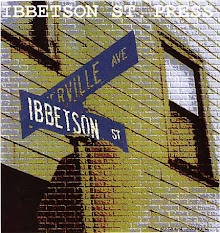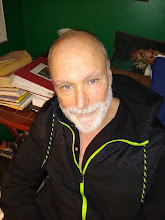https://www.instagram.com/reel/DMA8al8O9vB/... Nidia Hernández's (NEW ENGLAND POETRY CLUB BOARD MEMBER) video of the late Fanny Howe
Saturday, July 12, 2025
Fanny Howe Video
Friday, July 11, 2025
Red Letter Poem #261
The Red Letters
I
In ancient Rome, feast days were indicated on the calendar by red letters.
To my mind, all poetry and art serves as a reminder that every day we wake together beneath the sun is a red-letter day.
––Steven Ratiner
Red Letter Poem #261
The Two Liberations of Crispus Attucks
First from his master who had
This to say about
The Mulatto Fellow, about 27
Years of Age, named Crispas.
How his hair was short and curl’d
His knees nearer together
Than common, and his bear-skin
Coat light-colored. That his
Britches were made of new
Buckskin, his yard stockings
Blue, his woolen shirt checked.
What he did not see
Is what he did Not See.
The empty space of Crispus.
How like smoke, like nothing,
Like dust he disappeared.
So to write him in—to restore
The It of him, the ad and mug-
Shot payed-for and run. October
2, 1750, Boston Gazette:
Whoever shall take up said
Run-away, and convey him
To his abovesaid Master, shall
Have Ten Pounds, old Tenor
Reward, and all necessary charges
Paid. And all masters of Vessels
And others, are hereby
Cautioned against concealing
Or carrying off said Servant
On Penalty of the Law.
For the weight of him,
For the worth of him,
Who stands presently
Martyr and master
Of his wounded and full
Self, first among men
Before enslavement,
Among them the actual
Unconceptually detained.
Crispus taking the first
Bullet like a 21st century
Black man, like a Black
Man in a car to convey
Him up the freeway.
The way to free.
The way from tyranny.
––Danielle Legros Georges
"What, to the Slave, Is the Fourth of July?" That was the title of a speech delivered by Frederick Douglass on July 5, 1852, at Corinthian Hall in Rochester, New York. Douglass was, of course, the American abolitionist, social reformer, compelling orator, writer, and statesman nonpareil––an acclaimed figure at a time when the vast majority of his fellow black men and women living in these United States would have been considered the equivalent of a horse or carriage: property. If you think about how outraged many in Donald Trump’s America would be by the tone (let alone content) of this address, imagine how utterly revolutionary this would have seemed, eleven years prior to the Emancipation Proclamation. Invited to deliver this Independence Day speech, organized by the Rochester Ladies' Anti-Slavery Society, Douglass began to respond to his own query this way: “I answer: a day that reveals to him, more than all other days in the year, the gross injustice and cruelty to which he is the constant victim. To him, your celebration is a sham; your boasted liberty, an unholy license; your national greatness, swelling vanity; your sounds of rejoicing are empty and heartless; your denunciation of tyrants, brass-fronted impudence; your shouts of liberty and equality, hollow mockery; your prayers and hymns, your sermons and thanksgivings, with all your religious parade and solemnity, mere bombast, fraud, deception, impiety, and hypocrisy––a thin veil to cover up crimes which would disgrace a nation of savages.”
It is always a challenge for any chronicler to make use of centuries-old documentation in such a way as to preserve its historical potency without leaving contemporary readers too much in the dark. Most poets shy away from attempting this. But Danielle Legros Georges did this often, and with unusual efficacy and grace––especially in Acts of Resistance to New England Slavery by Africans Themselves in New England––the small chapbook from Staircase Books published posthumously this year. That word, posthumously, hits especially hard at those who associate the poet with her vibrant spirit, commitment to community, and seemingly bottomless reservoir of energy––even when (we would find out only belatedly) Danielle was suffering from a slow terminal illness. She was determined to live her life on her own terms and with her unique sense of imaginative imperative. In these final poems, she explores the history of enslaved people in the liberal enclaves of New England colonial states, making extensive use of newspaper accounts, slave papers, legal documents, and contemporaneous historical writing. The unusual spelling and syntax she borrows make us feel both distant from these sources and also strangely intrigued––as if we were eavesdropping on some alien world which, it turns out, was situated upon the very ground we presently inhabit. If your memory of high school history class is somewhat a blur, I’ll remind you who Crispus Attucks was: sailor and whaler from Framingham, MA; a man of African and Native American ancestry; and, like Douglass a century later, an escaped slave. He was also part of a rowdy protest in March of 1770 that resulted in British soldiers firing upon the crowd. Attucks was thought to have been the first to die––perhaps the earliest casualty of the approaching Revolutionary War. Contrast this pivotal role in history with how his former ‘owner’ saw him: a sketchy list of clothing items and physical traits. But then the poet illuminates the situation by saying: “What he did not see// Is what he did Not See./ The empty space of Crispus.”
Poets know how language conveys the overt meaning of the speaker while also betraying the covert intent. How easily the mind ricochets from “run” (as in a notice in a newspaper) to “runaway” (with visions of slave-catchers and manacles.) If the stance throughout much of the poem feels like that of the historian, nearing the conclusion the incendiary intent of the poet is revealed: “Crispus taking the first// Bullet like a 21st century/ Black man, like a Black// Man in a car to convey/ Him up the freeway.// The way to free./ The way from tyranny.” The contortions of language reveal just how hard the struggle has been to assess the distance between those antebellum slave days and our (supposedly) ‘post-racial’ 21st century America. Douglass’s rhetoric and the magnitude of its righteous indignation function like a sledgehammer. But Danielle’s language is more elliptical, subdued––right up until she places a needle into the center of the wound, shocking us with the reminder of how slowly the racial landscape has changed across the two-and-a-half century arc within this poem.
I will not spend my remaining sentences here detailing Danielle’s accomplishments (though I hope you’ll explore them further online.) I will only hint at the mark a poet can actually make upon this world, represented simply by some of what has been planned in her absence: France’s Ministry of Culture posthumously awarded Danielle a Chevalier de L’Ordre des Arts et des Lettres; the newly redesigned Copley Square Park will feature her poem “How many kinds of love,” carved into the stone; a scholarship in her name is planned for students of Boston Public Schools; and the New England Poetry Club’s biannual fellowship for young writers of color will be titled in Danielle’s honor. These will now themselves become historical facts. And who, in the unscrolling years, will be moved by them and incorporate such reflective moments into poems?
The Red Letters
* If you would like to receive these poems every Friday in your own in-box – or would like to write in with comments or submissions – send correspondence to:
steven.arlingtonlaureate@gmail.com
* To learn more about the origins of the Red Letter Project, check out an essay I wrote for Arrowsmith Magazine:
https://www.arrowsmithpress.com/community-of-voices
and the Boston Area Small Press and Poetry Scene
http://dougholder.blogspot.com
* For updates and announcements about Red Letter projects and poetry readings, please follow me on BlueSky
@stevenratiner.bsky.social
and on Twitter
@StevenRatiner
And coming soon:
a new website to house all the Red Letter archives at StevenRatiner.com
Monday, July 07, 2025
Sunday, July 06, 2025
Somerville Poet Mollie O'Leary: A poet of Memories
How has it been for you as a poet living in Somerville?
Somerville and the surrounding neighborhoods have a really vibrant arts and poetry scene. I’ve met a lot of people through poetry, including a local group of Boston poets called the Chickadee Collective. It’s been really inspiring and energizing to connect with people who share a love of language and want to talk about it!
You studied at Kenyon College with Somerville Poet Jennifer Clarvoe—how did this experience shape you as a writer?
Jennifer taught my Introduction to Poetry workshop when I was sophomore in college which was hugely influential since I was just starting out and finding my voice. I was also in her Prosody and Poetics class where I learned more about the musicality and rhythm of poetry. I remember we had to memorize and recite poems in her class, and that was such an interesting exercise in what lines, rhymes, or metaphors tend to stick with you and why that might be. It was a wonderful surprise to run into Jennifer at a coffee shop in Somerville almost 10 years since I took my first class with her!
Reading your poem " The Forgetting Curve," I am reminded of Elizabeth Bishop's "One Art" with its opening line " The art of losing is not hard to master." Was Bishop an influence for you?
Almost all of my mentors and various readers have drawn parallels between myself and Bishop—and I love that! Bishop has always been a big influence. I was actually introduced to her poem ‘Sestina’ in a class with Jennifer. Bishop’s understatement in that poem while also being so straightforward and honest with the reader struck me and has stayed with me ever since. Studying Bishop’s emotional restraint and her use of unadorned yet moving language has helped me write some of my more difficult poems like “Anti-Elegy.”
Why should we read your work?
My poetry is very interested in memory and how it shapes our understanding of ourselves and our connections with others, especially in the wake of traumatic or emotionally difficult events. If you have memories that you are both hesitant to remember yet afraid to forget, I think you’ll connect with my work.
sour mildew budding. I wake to pink biofilm
on graying porcelain. Even slime mold has memory;
its amoeba body retrieves oat flakes. After I scythe
seven inches of hair, still I feel long strands running
down my spine. Ever since the flood, I try not to hold
onto much, exfoliate dead cells as if this excess
might weigh down a life raft. I slip pale sea glass
into my pocket only to part with it once I reach the car.
I used to capture wild hermit crabs, place them
in salted tap water, swooshing the tupperware
to mimic waves. I thought I could trick them
into being home. The hermit crabs lasted a day,
leaving behind their tiny calcified capsules, perfect
like piped frosting. The brain wants to be buoyant,
shedding ghosts to avoid overgrowth. We’re meant
to slough off the past, but I still don’t know
where to keep the shells the tide gives back.
.webp)




































